73 F. average high on May 27.
70 F. high on May 27, 2016.
May 28, 1965: Late season snow falls across much of Minnesota with Duluth and Caribou reporting an inch.

Looks Like a Major Holiday: Cooler, Few PM Showers
Good news: it won't snow anytime soon. No flying monkeys on Doppler. No hail the size of beach balls or Texas-size tornadoes - the atmosphere is too cool and stable. Think of all the money you'll save on sunscreen and A/C in the coming days!
Is any of this helping? I didn't think so.
So let me ask an impertinent question: how many times do you have to get hit over the head with a (soggy) two by four before you start to pay attention? According to friend and climate guru Mark Seeley, this is the 6th time in the past 7 years that May is trending wetter than average across Minnesota. Like it or not our climate is getting wetter.
No all-day rains are brewing, but a cold storm in the upper atmosphere will ignite a few popcorn instability showers this afternoon, again Memorial Day - along with a brisk northwest wind and temperatures drooping into the low 60s tomorrow. Only the brave and foolish will risk a dip in the lake.
If it's any consolation the European (ECMWF) model brings 80s into town next weekend. With a little effort you may even be able to work up a sweat.
Imagine that.
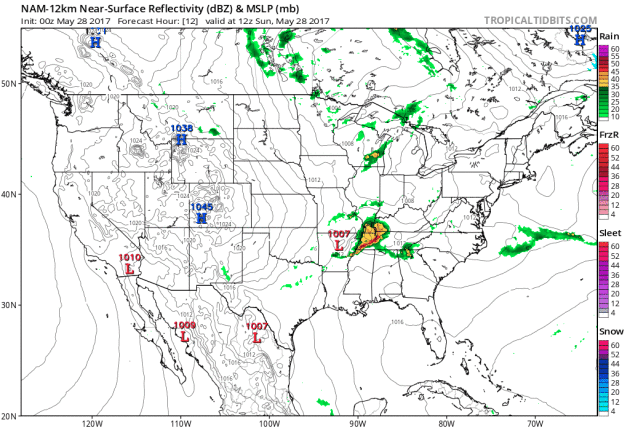
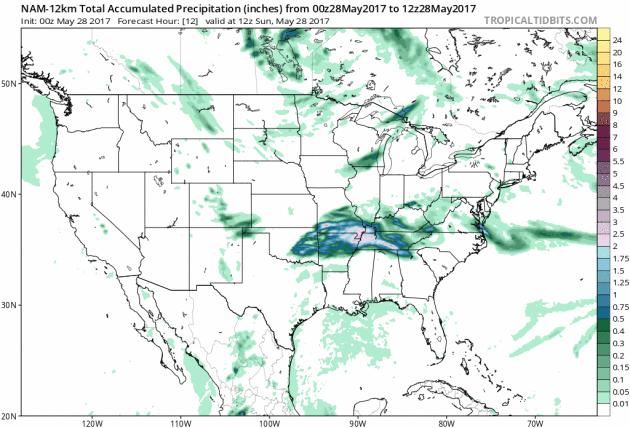
This Is What It's Like To Be Struck by Lightning. 9 out of 10 people struck survive, but many have lifelong ailments. A story at CNN.com caught my eye: "...Lightning is responsible for more than 4,000 deaths worldwide annually, though of every ten people hit, nine survive. But victims can suffer a variety of short- and long-term effects: cardiac arrest, confusion, seizures, deafness, headaches, memory deficits, personality changes and chronic pain, among others. Changes in personality and mood can strain families and marriages, sometimes to breaking point. Cooper likes to use the analogy that lightning rewires the brain in much the same way that an electrical shock can scramble a computer -- the exterior appears unharmed, but the software within that controls its functioning is damaged..." (File image: NASA).
Persistent Rain in May. Dr. Mark Seeley takes a look at what is turning into another historically-wet May for much of Minnesota in this week's installment of Minnesota WeatherTalk: "Over the calendar period May 15-22, some Minnesota climate observers reported rainfall every day (8 consecutive days), and a large number of them reported rainfall on 7 of the 8 days. In addition, on some individual days the rainfall was slow but persistent, lasting for as much as 12-14 consecutive hours. Over May 15-22 within the Minnesota daily climate observation network there were 36 new daily rainfall records set. Some examples include: 2.96” at Hokah (Houston County) on May 16; 1.95” at Red Wing Dam (Goodhue County) on May 17; 2.09” at Morris (Stevens County) on May 18; and 1.32” at Milaca (Mille Lacs County) on May 21st. Total rainfall for the month of May is well above normal in most places, and in some areas is approaching values close to the historically wettest May. Many areas of the state report 4 to 7 inches of rainfall so far this month. This is the 6th time in the past seven years that May has been wetter than normal across the state...."
Harnessing Nature to Manage Rising Flood Risk. Phys.org has a story focused on natural defenses against rising water: "...Globally,
flooding is the most common disaster risk, accounting for nearly half
of all weather-related disasters during the past 20 years. Exposure and
vulnerability to flood risks are on the rise: the proportion of the
world population living in flood-prone river basins has increased about
114 percent and population exposed to coastal areas has grown 192
percent during the last decade. "We can't afford to continue to invest
in short term solutions that don't take into account how weather
patterns, sea levels and land use are changing the nature and severity
of flooding," said Anita van Breda, World Wildlife Fund's senior
director of environment and disaster. "The traditional approaches we've
used to manage flooding in the past - like sea walls and levees - in
most cases, won't work in isolation for the types of floods we're likely
to experience in the future..."
Photo credit: Walt Jennings, FEMA.
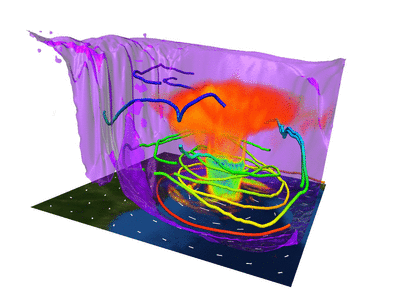
Globally,
flooding is the most common disaster risk, accounting for nearly half
of all weather-related disasters during the past 20 years. Exposure and
vulnerability to flood risks are on the rise: the proportion of the
world population living in flood-prone river basins has increased about
114 percent and population exposed to coastal areas has grown 192
percent during the last decade.
"We can't afford to continue to invest in short term solutions that don't take into account how weather patterns, sea levels and land use are changing the nature and severity of flooding," said Anita van Breda, World Wildlife Fund's senior director of environment and disaster. "The traditional approaches we've used to manage flooding in the past – like sea walls and levees – in most cases, won't work in isolation for the types of floods we're likely to experience in the future."
Read more at: https://phys.org/news/2017-05-harnessing-nature.html#jCp
"We can't afford to continue to invest in short term solutions that don't take into account how weather patterns, sea levels and land use are changing the nature and severity of flooding," said Anita van Breda, World Wildlife Fund's senior director of environment and disaster. "The traditional approaches we've used to manage flooding in the past – like sea walls and levees – in most cases, won't work in isolation for the types of floods we're likely to experience in the future."
Read more at: https://phys.org/news/2017-05-harnessing-nature.html#jCp
Globally,
flooding is the most common disaster risk, accounting for nearly half
of all weather-related disasters during the past 20 years. Exposure and
vulnerability to flood risks are on the rise: the proportion of the
world population living in flood-prone river basins has increased about
114 percent and population exposed to coastal areas has grown 192
percent during the last decade.
"We can't afford to continue to invest in short term solutions that don't take into account how weather patterns, sea levels and land use are changing the nature and severity of flooding," said Anita van Breda, World Wildlife Fund's senior director of environment and disaster. "The traditional approaches we've used to manage flooding in the past – like sea walls and levees – in most cases, won't work in isolation for the types of floods we're likely to experience in the future."
Read more at: https://phys.org/news/2017-05-harnessing-nature.html#jCp
"We can't afford to continue to invest in short term solutions that don't take into account how weather patterns, sea levels and land use are changing the nature and severity of flooding," said Anita van Breda, World Wildlife Fund's senior director of environment and disaster. "The traditional approaches we've used to manage flooding in the past – like sea walls and levees – in most cases, won't work in isolation for the types of floods we're likely to experience in the future."
Read more at: https://phys.org/news/2017-05-harnessing-nature.html#jCp

The Hurricane-Prone U.S. Coast Keeps Growing and Growing. Meteorologist Matt Lanza takes a look at population growth in some of America's most hurricane-prone coastal communities at Medium: "...So
what is the takeaway here? As a meteorologist, seeing that Eastern
United States coastal areas have added over 4.6 million people since
2010 is a bit unsettling, especially given how many of those people have
gone to Texas and Florida, two of the most hurricane prone states in
the country. If there’s a glimmer of good news, it may be that as a
whole, coastal counties in the United States are adding residents at a
slightly slower pace than they were earlier in this decade. But those
hurricane-prone places, Florida and Texas, show no signs of slowing
down. In fact, Florida continues to slam on the accelerator..."
Graphic credit: "Texas continues to add plenty of people." Source: U.S. Census Bureau.
Empire Builder Train-Tornado of May 27, 1931. Agweek takes a look at what happens when an EF-3 tornado encounters a train: "...Around
4:30 that afternoon when The Empire Builder, the transcontinental
passenger train that originated in Seattle and was heading toward
Chicago, was actually struck by a tornado in Clay county. The train had
just left the Fargo station and was near Sabin as severe thunderstorms
were moving through the region. The train first experienced heavy rain
and gusty wind before the tornado (which has been estimated to be an F3
with wind between 136 and 165 mph) struck it broadside and lifted five
of the passenger coaches from the rails..."
Image credit here: "Tornado
meet The Empire Builder May 1931 The Empire Builder, bound from Seattle
to Chicago, was struck by a tornado, May 27, 1931. Only the 136-ton
locomotive remained on the track." Courtesy, Historic NWS Collection, NOAA
Tornado Test Part 4: Two Tornadoes for TWIRL. KHQA.com has an update: "...Like
the eye of a hurricane, the tornado can be seen on radar. The DOW
measures winds of 195mph just 600 feet above the ground. Unfortunately
pods were not able to be put in the path so the ground winds are
unknown. The damage caused by tornadoes is exactly what TWIRL is trying
to better understand, how buildings are ripped apart. How pieces of roof
become projectiles in tornadoes. They want to better understand the
structure of them in order to better engineer structures to make
buildings safer, also to lead to better forecasts to be better able to
predict when a tornado may hit and where..."
Tornado-Spawning Eastern US Storms Examined by NASA's GPM Satellite. EurekaAlert! Science News explains: "On
Wednesday May 24, 2017 severe weather affected a large area of the
eastern United States. That's when the Global Precipitation Measurement
mission or GPM core satellite passed over the area and found extremely
heavy rainfall and towering clouds in the system. Tornadoes were
reported in Florida, Georgia, South Carolina, North Carolina and Ohio on
that day. The National Weather Service noted that rainfall in
Tallahassee, Florida set a record at 1.52 inches on May 24. The GPM core
observatory satellite flew above a line of tornado spawning storms that
were moving through the Florida panhandle on May 24, 2017 at 10:26 a.m.
EDT (1426 UTC). GPM's Microwave Imager (GMI) and Dual-Frequency
Precipitation Radar (DPR) instruments collected data showing that very
heavy downpours were accompanying some of these storms..."
Image credit: "The
GPM core observatory satellite flew above a line of tornado spawning
storms that were moving through the Florida panhandle on May 24, 2017,
at 10:26 a.m. EDT. GPM data showed the storm tops located north of the
extreme storms in the Gulf of Mexico reached altitudes above 9.2 mile
(16 km) dropping rain at a rate of over 8.5 inches (215 mm) per hour." Credits: NASA/JAXA, Hal Pierce.
 Fractal - 4K StormLapse.
This may be the most amazing time-lapse weather video I've ever seen,
anytime - anywhere. You will be hypnotized by the imagery at Vimeo, courtesy of Chad Cowan: "Big
whirls have little whirls that feed on their velocity, and little
whirls have lesser whirls, and so on to viscosity." - Meteorologist
Lewis Fry Richardson ("Weather Prediction by Numerical Process."
Cambridge University Press, 1922) This quote sums up perfectly what I've
come to realize about weather and storms over the past 10 years of
studying, forecasting and chasing them, and the part that I find most
fascinating. On each scale level from synoptic scale, which covers areas
the size of multiple states, all the way down to micro scale, which
could be an area as small as your backyard, the fluid which we call air
abides by the same universal physical laws of nature and thus acts in
very similar manner and patterns..."
Fractal - 4K StormLapse.
This may be the most amazing time-lapse weather video I've ever seen,
anytime - anywhere. You will be hypnotized by the imagery at Vimeo, courtesy of Chad Cowan: "Big
whirls have little whirls that feed on their velocity, and little
whirls have lesser whirls, and so on to viscosity." - Meteorologist
Lewis Fry Richardson ("Weather Prediction by Numerical Process."
Cambridge University Press, 1922) This quote sums up perfectly what I've
come to realize about weather and storms over the past 10 years of
studying, forecasting and chasing them, and the part that I find most
fascinating. On each scale level from synoptic scale, which covers areas
the size of multiple states, all the way down to micro scale, which
could be an area as small as your backyard, the fluid which we call air
abides by the same universal physical laws of nature and thus acts in
very similar manner and patterns..."
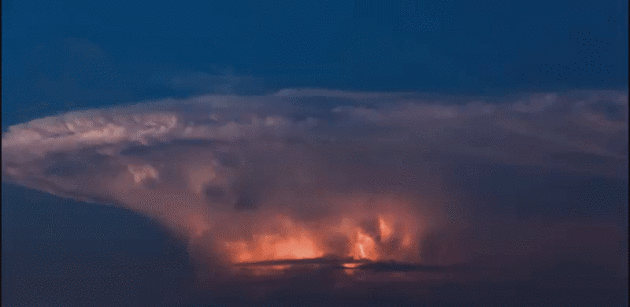
Overnight Tornadoes. The greatest risk of late-night tornadoes is along the Gulf Coast, where nearly 30% of all tornado warnings were issued between midnight and 8 AM from 2002-2017. Late-night tornadoes produce a disproportionate number of injuries and fatalities - people are sleeping, not monitoring media, more vulnerable to severe storms.
Illustration credit: "A report said that sand and gravel mining “greatly exceeds natural renewal rates.” Illustration by Javier Jaén.

Can Beaches Survive Climate Change? Here's an excerpt of a new paper abstract at USGS: "Anthropogenic climate change is driving sea level rise, leading to numerous impacts on the coastal zone, such as increased coastal flooding, beach erosion, cliff failure, saltwater intrusion in aquifers, and groundwater inundation. Many beaches around the world are currently experiencing chronic erosion as a result of gradual, present-day rates of sea level rise (about 3 mm/year) and human-driven restrictions in sand supply (e.g., harbor dredging and river damming). Accelerated sea level rise threatens to worsen coastal erosion and challenge the very existence of natural beaches throughout the world..."
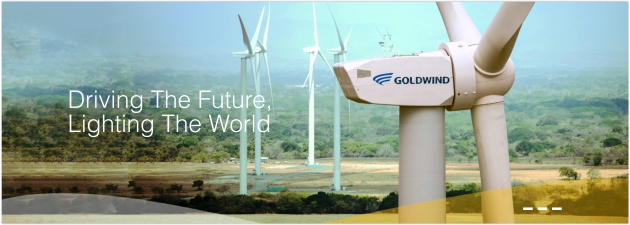
Wind Power Catches a Mountain Breeze. The largest wind installation in the USA in Wyoming? TIME has the story: "...Despite enormous potential, wind-power development in the Western mountain states has lagged behind other parts of the nation. The sparsely populated states don't need more electricity, and the excess power didn't have anywhere to go. But that's changing fast, as demand for wind power increases around the country and technological advances make it cheaper and easier to transmit.The biggest strides are being made in Wyoming, where two companies are racing to build massive wind farms to supply the West Coast. In Carbon County, the Power Company of Wyoming has broken ground on what will be the largest wind-power installation in the country. The completed project, which is projected to create 1,000 local jobs, calls for 1,000 wind turbines generating enough energy to power nearly a million homes..."
File photo: Matt Young, AP.
They Were Supposed to Help People Suffering From Addiction. Then They Overdosed. Opioids truly are the devil's drug, a point driven home after reading a post at Vox: "The
two counselors at a drug treatment halfway house in Chester County,
Pennsylvania, were supposed to help others recover from their
addictions. But they were overwhelmed by their own drug problems — and
on Sunday, they both overdosed and died on a mix of the opioids heroin
and fentanyl.
“If anybody is wondering how bad the opioid epidemic has become, this
case is a frightening example,” Chester County District Attorney Tom
Hogan said in a statement.
“The staff members in charge of supervising recovering addicts
succumbed to their own addiction and died of opioid overdoses. Opioids
are a monster that is slowly consuming our population...”
Image credit: ChrisRiddell.com.
Mossberg: The Disappearing Computer.
Computers? What computers? Walt Mossberg's last column proves why he's
been in a different league now for many years. We'll miss you Walt.
Here's an excerpt from Recode: "...I
expect that one end result of all this work will be that the
technology, the computer inside all these things, will fade into the
background. In some cases, it may entirely disappear, waiting to be
activated by a voice command, a person entering the room, a change in
blood chemistry, a shift in temperature, a motion. Maybe even just a
thought. Your whole home, office and car will be packed with these
waiting computers and sensors. But they won’t be in your way, or perhaps
even distinguishable as tech devices. This is ambient computing, the
transformation of the environment all around us with intelligence and
capabilities that don’t seem to be there at all..."
Photo credit: "This ragtag group of rebels went on to great victories." (Reuters/Fred Prouser)
Photo credit: "In This Mayy 19, 2017 photo, John Aldridge poses in Montauck, N.Y. with the boots that helped keep him afloat for 12 hours after falling off his lobster boat in the summer of 2013. Nearly 4 years later, he's still working in the profession that put him in so much danger. And he's retelling the remarkable tale in a book released the week of May 29, 2017." AP Photo/Frank Eltman.


TODAY: Some sun, PM shower possible. Winds: NW 10-15. High: 72
SUNDAY NIGHT: Evening shower, then partial clearing. Low: 52
MEMORIAL DAY: Windy and cooler with more numerous showers. Winds: NW 10-20. High: 62
TUESDAY: Mostly cloudy and cool, few sprinkles. Winds: NW 10-20. Wake-up: 48. High: 59
WEDNESDAY: Sunny, almost feels like May again. Winds: W 8-13. Wake-up: 45. High: 72
THURSDAY: Partly sunny, stray T-shower possible. Winds: SW 8-13. Wake-up: 53. High: 77
FRIDAY: Sticky sun, actually feels like June. Winds: S 7-12. Wake-up: 59. High: 82
SATURDAY: Warm and muggy with some sun, PM T-storm? Winds: SW 8-13. Wake-up: 63. High: 85
Climate Stories...
Photo credit: "Banner created by Alliance for Climate Education."
What the U.S. Could Learn From the Dutch on Climate Change. We're already taking advantage of their sea walls and levee technology as seas continue to rise and nuisance flooding increases. But there are other lessons, according to MIT Technology Review: "Earlier this month, the Netherlands completed one of the largest offshore wind farms in the world, as an accelerating wind boom finally helps the country make real progress on its renewable energy goals. The 600-megawatt Gemini wind park, operating 150 turbines in the North Sea, will serve some 1.5 million citizens. Several other major offshore wind farms are under development as well, which will collectively push total wind capacity to nearly 4.5 gigawatts by 2023 (see “The Wind Fuels the North Sea’s Next Energy Boom”). “As a country we were heavily dependent on fossil fuels, and our way to renewables has been bumpy,” Sharon Dijksma, the nation’s minister for the environment, told MIT Technology Review this week. “So this government decided that we needed to step up the pace...”
Photo credit: "The Gemini wind farm includes 150 turbines in the North Sea."
So Much Water Pulsed Through a Melting Glacier That It Warped the Earth's Crust. Details via The Washington Post: "NASA scientists detected a pulse of melting ice and water traveling through a major glacier in Greenland that was so big that it warped the solid Earth — a surge equivalent in mass to 18,000 Empire State Buildings. The pulse — which occurred during the 2012 record melt year — traveled nearly 15 miles through the Rink Glacier in western Greenland over four months before reaching the sea, the researchers said. “It’s a gigantic mass,” said Eric Larour, one of the study’s authors and a researcher at NASA’s Jet Propulsion Laboratory. “It is able to bend the bedrock around it.” Such a “wave” has never before been detected in a Greenland or Antarctic glacier..."
Photo credit: "Rink Glacier on Greenland’s west coast." (NASA/John Sonntag).
Rising Seas May Wipe Out These Jersey Towns, But They're Still Rated AAA. Bloomberg reports: "Few parts of the U.S. are as exposed to the threats from climate change as Ocean County, New Jersey. It was here in Seaside Heights that Hurricane Sandy flooded an oceanfront amusement park, leaving an inundated roller coaster as an iconic image of rising sea levels. Scientists say more floods and stronger hurricanes are likely as the planet warms. Yet last summer, when Ocean County wanted to sell $31 million in bonds maturing over 20 years, neither of its two rating companies, Moody’s Investors Service or S&P Global Ratings, asked any questions about the expected effect of climate change on its finances..."
No comments:
Post a Comment